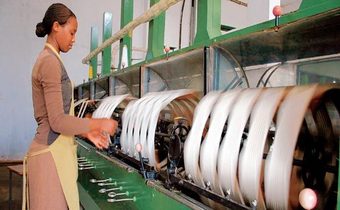 A group of women in Western Kenya are recording a doubling of earnings as they delve into rearing of silkworm for production of raw silk which is seeing them diverge their farming while easing pressure on their land. Silkworm rearing is also helping them boost environmental conservation.
A group of women in Western Kenya are recording a doubling of earnings as they delve into rearing of silkworm for production of raw silk which is seeing them diverge their farming while easing pressure on their land. Silkworm rearing is also helping them boost environmental conservation.
The women belonging to The Kambogo Women's Group of Rachuonyo district are, among the only active silkworm farming group in the country. But their decision has been so rewarding that some farmers have replaced sugarcane with mulberry the staple diet for silkworms. Given financial support, the Kambogo group claims that it could transform small-scale growers into major silk farmers with high incomes within two years. Moreover, the activity is starting to be replicated in other neighbouring districts.
The group chairperson, Ms Pamela Onyango, says she initially reared silkworms in her grass-thatched house, having learnt the skill of egg production from a silk farming group in Buseni, Uganda. To form the cocoon, she explains, silkworm larvae feed on mulberry leaves before climbing onto a twig placed nearby, where they spin their silken cocoons. The silk formed is a continuous-filament fibre. These single filaments are combined to form yarn, which is drawn under tension through several guides and wound onto reels. Finally, the yarn is dried, and the raw silk is packed according to quality. Silkworm waste can be collected and used as manure for mulberry plants.
After acquiring basic skills in rearing silkworms from the International Centre for Insect Physiology and Ecology (ICIPE), the Kambogo women sought support from the divisional agricultural office and the Ministry of Livestock to make silk farming a reality. The group of 30 women began planting mulberry in 2001 and currently has over 15 acres of mulberry bushes.
The group has now commercialised their activities by selling the cocoons on a monthly basis to the Kenya Agricultural Research Institute (KARI) in Thika. The group also offers lessons, at a small fee, to farmers who want to practice silk farming. And the benefits, says Ms Onyango, are clear: "People are willing to practise silk farming because it is less tedious, yet it brings income on a monthly basis. As a group, our monthly earnings are at least Sh100,000. This is a sign that Kenyans have a potential solution to rampant poverty," she noted.
Ensuring a sustainable source of livelihood for farmers, mulberry trees can be used for at least 20 years before slowing in growth and needing replacement. Caroline Atieno, one of the silk farmers, says she was very sceptical when she started rearing silkworms, "but honestly, there is so much to show in terms of income." She has been able to educate her nine children through primary and high school, earning at least US$150 per month.
As a pioneer silk farmer, Atieno is now selling mulberry leaves and silkworms to newcomers in the business. Her only concern is whether the group will be able to supply enough mulberries and worms to meet growing demand, due to limited resources. Joyce Wainaina of the Sericulture Department at KARI Thika agrees, explaining that while the Kambogo women have strived to make silk farming a reality, "they need a financial boost to make it sustainable enough to meet high demand."
Given their courage and ambition, it can only be hoped that investors will recognise the potential and complete their transformation from subsistence farmers to full-time silk producers.